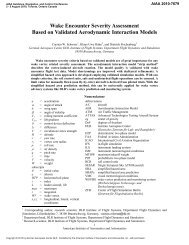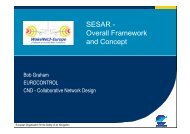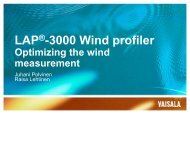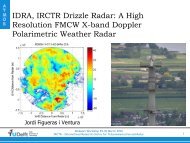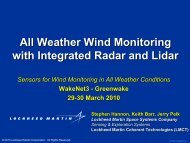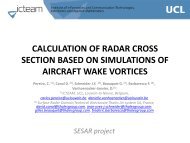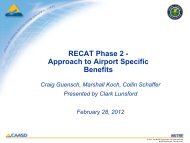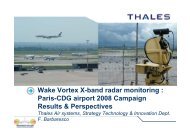Electronic-Scanning X-band Wake Vortex Radar - Wakenet
Electronic-Scanning X-band Wake Vortex Radar - Wakenet
Electronic-Scanning X-band Wake Vortex Radar - Wakenet
Create successful ePaper yourself
Turn your PDF publications into a flip-book with our unique Google optimized e-Paper software.
<strong>Wake</strong> <strong>Vortex</strong> Detection• Airport systems for real-time detection and monitoring of wake vortices at take-offand landing are in the research and development stage both in the U.S. andEurope• There is a key need to increase airport safety and to increase air traffic throughputby reducing aircraft separation in crosswind conditions• LIDAR (LIght Detection And Ranging) sensors have been tested, but their utiltyappears to be limited to clear air conditions• Low power X-<strong>band</strong> radar can potentially provide all-weather wake vortexdetection, and provide high-resolution weather monitoring in the TMABarbaresco et al., “<strong>Wake</strong> <strong>Vortex</strong> Detection & Monitoring by X-<strong>band</strong> Doppler <strong>Radar</strong>: Paris Orly<strong>Radar</strong> Campaign Results,”Page 3
<strong>Wake</strong> <strong>Vortex</strong> <strong>Radar</strong> Performance GoalsDetection range: 2 kmFront-end characteristics:Frequency range : X Band (9.6GHz nom)RCS Detection: 0.01m2 (nom)Dynamic Range: 90 dB per Vaisala RVP900Pulse to Pulse phase stability : per Vaisala RVP900Digital sampling rate (IQ): per Vaisala RVP900Beam characteristics:Full 2D (azimuth and elevation) electronic scanning<strong>Electronic</strong> beam scanning range: +/- 15 ° (in elevation plane), +/- 45° (in azimuth plane)Mechanical tilt antenna face in elevation: -10 ° to 90° (zenithal)Elevation beamwidth: 1° to 2°Azimuth beamwidth: 1° to 2°Dual polarization at reception : HH and VVVolume exploration renewal period: 1s to 200s (depending on operating mode)Waveform characteristics:Duty cycle: > 20 %,Pulse duration: 0.5 μs to 40 μs,Pulse repetition interval : 400 μs to 1000μs,Range resolution : 40 metersPage 4
Weather Detection – CASA• Traditional ground-based weather surveillance has relied on a sparse populationof large long range high power radars (e.g. NEXRAD WSR-88 S-<strong>band</strong> radars)• However, there is a need to be able to provide coverage at lower altitudes as wellwhere the current long-range radar networks have significant gapsNEXRAD coverage at 3 km (~10k ft) AGL.NEXRAD coverage at 1 km (~3200 ft) AGL.Wide spacing and earth curvatureprevents the radars from seeingdown low, where weather hazardsthat impact human activity areoccurringPage 5
CASA Test NetworkIP1 LocationTest bed #1 in tornado alley7,000 sq km domainFloods and Tornadoes- #1 and #2 weather hazard for injuries and deaths- occur at ground level- occur on very short time scales- occur on very small space scalesKSAOKRSPCASA Network- 4 <strong>Radar</strong>sintegrated withNEXRADs- Prototypenetwork datacompared toNEXRAD only- CASA producesdetailed weatherKCRYKLWEPage 6
Typical <strong>Radar</strong> Performance - WeatherParameterValueCenter Frequency9.6 GHzOperating Bandwidth80 MHzInstantaneous Bandwidth 6 MHzPRF3.4 kHzPeak Transmit Power100 WEl Beamwidth (Broadside) ~2°Az Beamwidth (Broadside) ~2°Elevation Scan Range 0-30°Azimuth Scan Range ±45°Antenna Gain (Broadside) 39 dBMaximum Range30 kmRange Resolution25 mPulse Width4.16 – 41.67 μsDuty Cycle 20-30%Noise Figure5 dBSystem Losses5 dBMinimum Detectable Signal ~ -100 dBmPage 7
X-Band <strong>Radar</strong> Technology ApplicationFuture Weather System Technology-Elec Scan (2010)ArrayAssembliesChassisRear CoverAir-Air HeatExchangerCurrent Weather SystemTechnology-Mech Scan (2005)Array FrameAssemblyRadomeAssembly8 ft 2 TowerAssemblyArrayAssembliesTowerAssemblyCharacterstics:1 m x 1 m X-<strong>band</strong> antennas2 degree pencil beamSingle and dual V & H polarizationconfigurations10’s Watt average power
Weather / <strong>Wake</strong> <strong>Vortex</strong> X-Band X<strong>Radar</strong> PackageMechanical rotationhardware in azimuthand eleva tionra domeRVP900 SignalPro cessing Unit<strong>Radar</strong> Signal Receiver<strong>Radar</strong> Sig nal ProcessingSP data recording system(Opti onal)Interfaces w ith data processing<strong>Radar</strong> Sign al Gen erator<strong>Radar</strong> Data ProcessingPower andcoolingAntenna panel (active antenna with Tx modulein SiGe Technology) :- Tx and Rx modules-Antenna Cont rol Syst em-Be am S teering UnitPage 9
Weather / <strong>Wake</strong> <strong>Vortex</strong> Demo ConfigurationWeather Test Configuration<strong>Wake</strong> <strong>Vortex</strong> Test ConfigurationDemoArray at10° EL15’Ø FreeStandingRadomeand ringDemo Arrayat 90° ELTest PlatformAirConditionerDemoArrayChillerAntennaMountPage 10
Demo Array – Panel CCA Assembly Overview• Building Block PanelPWB consists of 128identical unit cells– 18 layer board– Slot fed single PatchRadiator• Each unit cell containssingle SiGe Flip Chip,Linear Regulator, andassociated Caps /resistors• 4 Power, 4 Logicconnectors and 1 RFConnectorRadiatorActive ComponentsActive Component SidePage 11
SiGe T/R MMIC Description• The <strong>Wake</strong> <strong>Vortex</strong> / Weather <strong>Radar</strong> T/R MMIC is a mixed-signal circuitcontaining Microwave, Analog, and Digital circuitry.• The T/R MMIC provides the full functionality of a T/R module on a chip,providing final output power in Transmit, setting noise figure in Receive,and amplitude/phase control for beam steering.• The T/R MMIC has been designed for IBM’s SiGe 7HP BiCMOS processfollowed by proprietary Topside post-processing.• The microwave circuitry consists of:– Power Amplifier (PA)– Low Noise Amplifier (LNA)– Common Leg Circuit (CLC) containing two Gain Amplifiers, a 4 bit PhaseShifter, a 5 bit Attenuator, and a Transfer switch– Transmit/Receive (T/R) switches– Horizontal/Vertical (H/V) Polarization switches• The analog circuitry consists of bias controls to support the amplifiers ofthe RF functions as well as the internal digital requirements.• The digital circuitry decodes the incoming digital commands and providesthe logic controls for the phase shifter, attenuator, and switches.Reference DDTC Case CJ 646-09 dated 12/29/09 for EAR99 classificationPage 12
Silicon Germanium Transmit/Receive MMIC5.7 mm x 3.5 mmWeather <strong>Radar</strong> TransceiverMMIC design optimized forlow power <strong>Wake</strong> <strong>Vortex</strong> andWeather radarrequirements• 0.18 μm IBM SiGe 7HP BiCMOS• Selectable H/V polarization• 4-bit phase shifter/5-bit attenuator• Ultra low-power CMOS switches• Selectable LNA front-end• 125 mW power amplifier• 128 bit SRAM• Designed for flip-chip assemblyReference DDTC Case CJ 646-09 dated 12/29/09 for EAR99 classificationPage 13
The RVP900 Vaisala SigmetDigital Receiver and Signal ProcessorFeaturesThe RVP900TM provides comprehensive digitalIF and signal processing functions on an openLinux PC platform• 100 MHz, 16-bit IF sampling improvingsensitivity and dynamic range in 5 independentchannels• 38.4 Billion multiply accumulates cycles persecond which is a x5 increase over the RVP8TM• PCI bus-less architecture allowing theRVP900TM to be PC independent. The nextgeneration hardware is the next faster PC chip.• Independent and parallel FIR filtering allowingdual pulse width and dual frequency transmitstrategies• Dual Polarization, Wide Dynamic Range, andPulse Compression ready.Page 14
The RVP900 Vaisala SigmetTechnical DataDigital Receiver________________________IF INPUTS5 separate and identical channels allowing multipleapplications such as dual-polarization with ultra-widedynamic range: 50-Ω, +8.0 dBmIF RANGESSelectable: 5-130 MHzDYNAMIC RANGE90 to >105 dB depending on matched filter (e.g., >105dB for 0.5 MHz matched filter). Optional 20 dB ultrawide dynamic range extension using additional IF inputchannelsA/D CONVERSION16 Bits at up to 100 MHz with jitter < 1.0 picosecondsPHASE STABILITYKlystron: Better than 0.1 degreesMagnetron: Better than 0.5 degrees (for 1.0microsecond pulse)IF WAVEFORM GENERATORDual 16-bit TxDAC at 10-75MHz with 65 dB SNR10-125MHz on the TxDDS outputSignal Processor__________________________OUTPUTdBZ, V, W, Polarization parameters: 8 or 16 bits; I & Q: 16 bits;FFT: 16 bits. Real-time display.SERVER SPECIFICATIONSDual Quad-Core Intel Xeon processors and 1333 MHz SystemBus speed offering 5X the processing power of the RVP8TMserver.2 X 250 GB SATA Hard driveTCP/IP 100/1000 BT Host interfaceRemote Intelligent Platform Management Interface (IPMI) withonboard sensors and BITEPhysical and Environmental _______________PACKAGINGDigital Receiver: 243 x 169.5 x 81.6 mm including fan.Signal Processor: 1U rack mount chassis.ENVIRONMENTALDigital Receiver: 0 – 50 C operating, 0 – 95% (noncondensing)R.H.Signal Processor: 10 – 35 C operating, 8 – 90%(noncondensing) R.H.RELIABILITYDigital Receiver: >50,000 Hours MTBF (at 25C)Page 15




